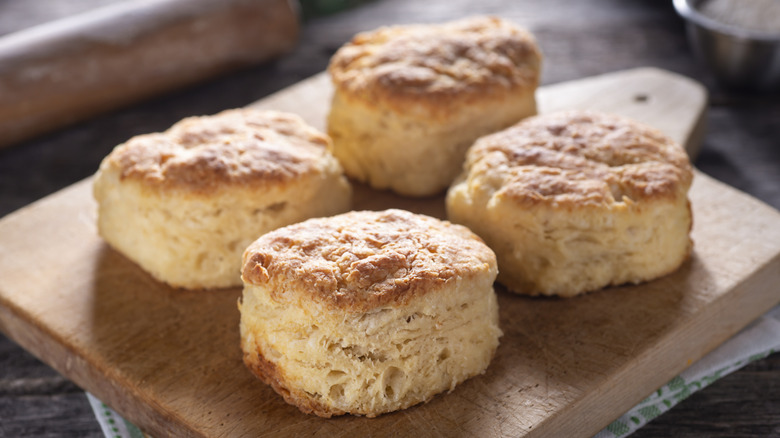The Secret To Taller Biscuits? Overcrowd Them In The Pan
The world of baking is filled with little bits of magic, like the transformation of a simple, shaggy dough into fluffy, delicious biscuits. Whether you use prepackaged biscuits that just need to be popped into the oven or you make them yourself, these classic Southern delicacies have become a staple of breakfast spreads around the world. While biscuits pair well with sweet fare like jelly or honey, they're also just as delicious with savory food and make an excellent base for breakfast sandwiches or a slathering of gravy. There are multiple hallmarks of a quality biscuit: a crisp exterior, a golden-brown hue, and tons of fluffy layers. But crafting the perfect homemade biscuit is no easy feat, and one element that can elude many home bakers is biscuit height.
A short, stumpy biscuit may still have the preferred rich, slightly salted taste, but it will lack the desired chewy texture. The shorter the biscuit, the more dense it will be since there won't be any room for airy, buttery layers. Fortunately, you can easily help your biscuits achieve new heights by packing them close together before you put them in the oven.
It's all about the spacing
If you've ever made something like chocolate chip cookies in the oven, you've no doubt noticed that the further away each piece of dough is from the others, the more space it has to spread out. The same concept applies to biscuits, which is why they may often come out of the oven relatively flat. To combat this, simply move the unbaked biscuits closer together. Leaving only ½ inch of space between each biscuit should help them rise to a satisfactory level. If you want even more height, arrange the dough rounds so they're barely touching one another, but don't squish them too tightly, or they may all form one giant mass. Baking your biscuits in a cast iron pan will also help them rise since the skillet's raised walls will stop the dough from spreading laterally.
Sometimes, a taller or shorter biscuit is better suited for certain applications. A slightly shorter biscuit can make biting into a stacked breakfast sandwich easier, while tall biscuits allow more room for soaking up gravy and other savory sauces. Feel free to experiment with how much you crowd your biscuits until you find the perfect height.
More ways to improve your biscuits
Along with crowding your biscuits close together in their pan or skillet, there are a few other actions you can take to ensure your biscuits tower over everything else on the plate. If you're making biscuits from scratch, make sure your ingredients are as cold as possible when assembling your dough — especially the butter. Throwing together a rough dough with still-visible chunks of butter will help prevent overmixing and will result in a taller, fluffier product.
When cutting your dough into individual pieces, make clean, decisive slices. A common mistake when making biscuits is twisting or sawing your cutting tool against the dough; this can create seals that will make the dough stick to itself and prevent it from rising uniformly. To form your biscuits, you may want to avoid a biscuit cutter altogether and instead make square biscuits using a knife or bench scraper. This way, you won't have any leftover dough that will need to be rerolled and formed into a new sheet — remember, you want to avoid handling the dough any more than necessary. Square biscuits also have a more rustic, homemade aesthetic and can rise just as tall when placed properly on the pan to bake.


